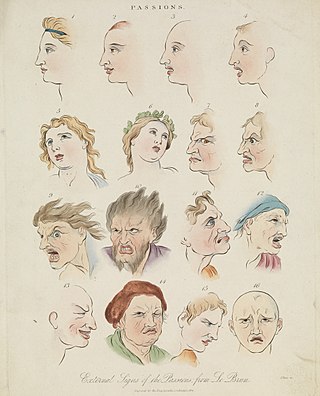
Emotions are physical and mental states brought on by neurophysiological changes, variously associated with thoughts, feelings, behavioral responses, and a degree of pleasure or displeasure. There is no scientific consensus on a definition. Emotions are often intertwined with mood, temperament, personality, disposition, or creativity.
Positive psychology studies the conditions that contribute to the optimal functioning of people, groups, and institutions. It studies "positive subjective experience, positive individual traits, and positive institutions... it aims to improve quality of life."
Amusement is the state of experiencing humorous and entertaining events or situations while the person or animal actively maintains the experience, and is associated with enjoyment, happiness, laughter and pleasure. It is an emotion with positive valence and high physiological arousal.
Sympathy is the perception of, understanding of, and reaction to the distress or need of another life form.
Moral psychology is a field of study in both philosophy and psychology. Historically, the term "moral psychology" was used relatively narrowly to refer to the study of moral development. Moral psychology eventually came to refer more broadly to various topics at the intersection of ethics, psychology, and philosophy of mind. Some of the main topics of the field are moral judgment, moral reasoning, moral sensitivity, moral responsibility, moral motivation, moral identity, moral action, moral development, moral diversity, moral character, altruism, psychological egoism, moral luck, moral forecasting, moral emotion, affective forecasting, and moral disagreement.

Affect, in psychology, refers to the underlying experience of feeling, emotion, attachment, or mood. In psychology, "affect" refers to the experience of feeling or emotion. It encompasses a wide range of emotional states and can be positive or negative. Affect is a fundamental aspect of human experience and plays a central role in many psychological theories and studies. It can be understood as a combination of three components: emotion, mood, and affectivity. In psychology, the term "affect" is often used interchangeably with several related terms and concepts, though each term may have slightly different nuances. These terms encompass: emotion, feeling, mood, emotional state, sentiment, affective state, emotional response, affective reactivity, disposition. Researchers and psychologists may employ specific terms based on their focus and the context of their work.

Dacher Joseph Keltner is a Mexican-born American professor of psychology at the University of California, Berkeley, who directs the Berkeley Social Interaction Lab. He is also the founder and faculty director of the Greater Good Science Center, host of the podcast The Science of Happiness, and chief scientific advisor of Hume AI.

Jonathan David Haidt is an American social psychologist and author. He is the Thomas Cooley Professor of Ethical Leadership at the New York University Stern School of Business. His main areas of study are the psychology of morality and moral emotions.

Determination is a positive emotional feeling that promotes persevering towards a difficult goal in spite of obstacles. Determination occurs prior to goal attainment and serves to motivate behavior that will help achieve one's goal.

Admiration is a social emotion felt by observing people of competence, talent, or skill exceeding standards. Admiration facilitates social learning in groups. Admiration motivates self-improvement through learning from role-models.
Prosocial behavior, or intent to benefit others, is a social behavior that "benefit[s] other people or society as a whole", "such as helping, sharing, donating, co-operating, and volunteering". Obeying the rules and conforming to socially accepted behaviors are also regarded as prosocial behaviors. These actions may be motivated by empathy and by concern about the welfare and rights of others, as well as for egoistic or practical concerns, such as one's social status or reputation, hope for direct or indirect reciprocity, or adherence to one's perceived system of fairness. It may also be motivated by altruism, though the existence of pure altruism is somewhat disputed, and some have argued that this falls into philosophical rather than psychological realm of debate. Evidence suggests that pro sociality is central to the well-being of social groups across a range of scales, including schools. Prosocial behavior in the classroom can have a significant impact on a student's motivation for learning and contributions to the classroom and larger community. In the workplace, prosocial behaviour can have a significant impact on team psychological safety, as well as positive indirect effects on employee's helping behaviors and task performance. Empathy is a strong motive in eliciting prosocial behavior, and has deep evolutionary roots.

The overview effect is a cognitive shift reported by some astronauts while viewing the Earth from space. Researchers have characterized the effect as "a state of awe with self-transcendent qualities, precipitated by a particularly striking visual stimulus". The most prominent common aspects of personally experiencing the Earth from space are appreciation and perception of beauty, unexpected and even overwhelming emotion, and an increased sense of connection to other people and the Earth as a whole. The effect can cause changes in the observer’s self concept and value system, and can be transformative.
Reverence is "a feeling or attitude of deep respect tinged with awe; veneration". Reverence involves a humbling of the self in respectful recognition of something perceived to be greater than the self.

People may face feelings of insignificance due to a number of causes, including having low self-esteem, being depressed, living in a huge, impersonal city, comparing themselves to wealthy celebrity success stories, working in a huge bureaucracy, or being in awe of a natural wonder.
Elevation is an emotion elicited by witnessing actual or imagined virtuous acts of remarkable moral goodness. It is experienced as a distinct feeling of warmth and expansion that is accompanied by appreciation and affection for the individual whose exceptional conduct is being observed. Elevation motivates those who experience it to open up to, affiliate with, and assist others. Elevation makes an individual feel lifted up and optimistic about humanity.
Vicarious embarrassment is the feeling of embarrassment from observing the embarrassing actions of another person. Unlike general embarrassment, vicarious embarrassment is not the feelings of embarrassment for yourself or for your own actions, but instead by feeling embarrassment for somebody else after witnessing that other person experiences an embarrassing event. These emotions can be perceived as pro-social, and some say they can be seen as motives for following socially and culturally acceptable behavior.
A functional account of emotions posits that emotions facilitate adaptive responses to environmental challenges. In other words, emotions are systems that respond to environmental input, such as a social or physical challenge, and produce adaptive output, such as a particular behavior. Under such accounts, emotions can manifest in maladaptive feelings and behaviors, but they are largely beneficial insofar as they inform and prepare individuals to respond to environmental challenges, and play a crucial role in structuring social interactions and relationships.

Daniel Cordaro is an American research scientist and psychologist who specializes in emotion psychology and human wellbeing. As a former faculty member at Yale University, Cordaro is best-known for his research in human emotion and positive psychology. Formerly the director of the Universal Expression Project at the University of California, Berkeley, Cordaro has conducted various worldwide studies on human emotional expression.
Moral emotions are a variety of social emotions that are involved in forming and communicating moral judgments and decisions, and in motivating behavioral responses to one's own and others' moral behavior. As defined by Jonathan Haidt, moral emotions "are linked to the interests or welfare either of a society as a whole or at least of persons other than the judge or agent". A person may not always have clear words to articulate, yet simultaneously, that same person knows it to be true deep down inside.
The psychology of social class is a branch of social psychology dedicated to understanding how social class affects individual's thoughts, feelings, and behaviors. While social class has long been a subject of analysis in fields such as sociology, political science, anthropology, medicine and epidemiology, its emergence within the field of psychology is much more recent.















